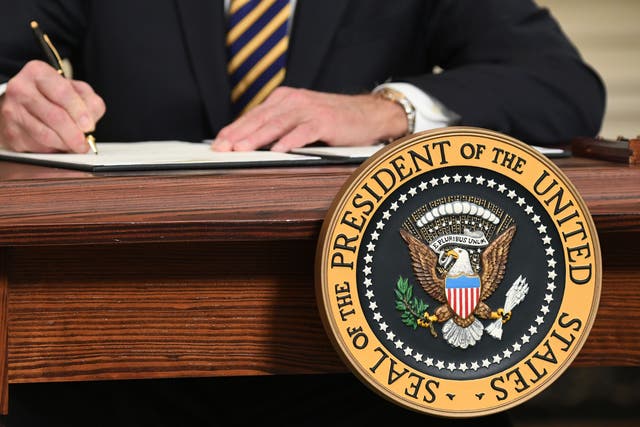

An executive order is an official directive from the U.S. president to federal agencies that often have much the same power of a law. Throughout history, executive orders have been one way that the power of the president and the executive branch of government has expanded—to degrees that are sometimes controversial.
The U.S. Constitution does not directly define or give the president authority to issue presidential actions, which include executive orders, presidential memoranda and proclamations.
Instead, this implied and accepted power derives from Article II of the Constitution, which states that as head of the executive branch and commander in chief of the armed forces, the president “shall take Care that the Laws be faithfully executed.”
Executive OrderWith an executive order, the president instructs the government how to work within the parameters already set by Congress and the Constitution. In effect, this allows the president to push through policy changes without going through Congress.
By issuing an executive order, the president does not create a new law or appropriate any funds from the U.S. Treasury; only Congress has the power to do both of these things.
Any executive order must identify whether the order is based on the powers given to the president by the U.S. Constitution or delegated to him by Congress.
Provided the order has a solid basis either in the Constitution, and the powers it vests in the president—as head of state, head of the executive branch and commander in chief of the nation’s armed forces—or in laws passed by Congress, an executive order has the force of law.
After the president issues an executive order, that order is recorded in the Federal Register and is considered binding, which means it can be enforced in the same way as if Congress had enacted it as law.
Just like laws, executive orders are subject to legal review, and the Supreme Court or lower federal courts can nullify, or cancel, an executive order if they determine it is unconstitutional.
Similarly, Congress can revoke an executive order by passing new legislation. These are examples of the checks and balances built into the system of U.S. government to ensure that no one branch—executive, legislative or judicial—becomes too powerful.
One prominent example of this dynamic occurred in 1952, after Harry Truman issued an executive order directing his secretary of commerce to seize control of the country’s steel mills during the Korean War.
But in its ruling in Youngstown Sheet & Tube Co. v. Sawyer later that year, the Supreme Court ruled that Truman’s order violated the due process clause of the Constitution, and that the president had not been given statutory authority by Congress to seize private property.
Virtually every president since George Washington has used the executive order in different ways during their administrations.
Washington’s first order, in June 1789, directed the heads of executive departments to submit reports about their operations. Over the years, presidents have typically issued executive orders and other actions to set holidays for federal workers, regulate civil service, designate public lands as Indian reservations or national parks and organize federal disaster assistance efforts, among other uses.
William Henry Harrison, who died after one month in office, is the only president not to issue a single executive order; Franklin D. Roosevelt, the only president to serve more than two terms, signed by far the most executive orders (3,721), many of which established key parts of his sweeping New Deal reforms.
Executive orders have also been used to assert presidential war powers, starting with the Civil War and continuing throughout all subsequent wars. During the Civil War, Abraham Lincoln controversially used executive orders to suspend habeas corpus in 1861 and to enact his Emancipation Proclamation in 1863.
And during World War II, FDR notoriously issued an executive order mandating the internment of Japanese Americans in 1942.
Several presidents have used executive orders to enforce civil rights legislation in the face of state or local resistance. In 1948, Truman issued an executive order desegregating the nation’s armed forces, while Dwight D. Eisenhower used an order to send federal troops to integrate public schools in Little Rock, Arkansas, in 1957.
Executive Order 9981: Desegregating U.S. Armed ForcesBetween 1789 and 1907, U.S. presidents issued a combined total of approximately 2,400 executive orders. Since 1908, when the orders were first numbered chronologically, presidents have issued more than 13,700 executive orders, reflecting the expansion of presidential power over the years.
New presidents often sign a number of executive orders and other actions in the opening weeks of their administration, in order to direct the federal agencies they’re taking over.
Recent presidents have taken this practice to new heights: In January 2017, Donald Trump set a new record for the number of executive actions issued by a new president in his first week, with 14 (one more than the 13 issued by his immediate predecessor, Barack Obama, in January 2009), including six executive orders. President Joe Biden surpassed that record during his first two weeks in office, signing over 30 executive orders.
Stream thousands of hours of acclaimed series, probing documentaries and captivating specials commercial-free in HISTORY Vault
Executive Orders, The Oxford Guide to the United States Government.
Executive Orders 101: Constitution Daily.
Executive Orders: Issuance, Modification and Revocation, Congressional Research Service.
Truman vs. Steel Industry, 1952, Time.
Executive Orders, The American Presidency Project.
What is an executive order? And how do President Trump’s stack up? Washington Post.
HISTORY.com works with a wide range of writers and editors to create accurate and informative content. All articles are regularly reviewed and updated by the HISTORY.com team. Articles with the “HISTORY.com Editors” byline have been written or edited by the HISTORY.com editors, including Amanda Onion, Missy Sullivan, Matt Mullen and Christian Zapata.